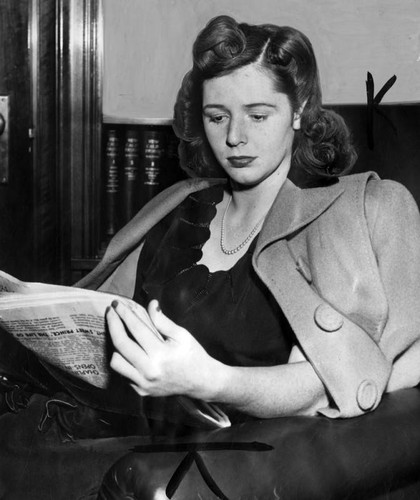Most of us think of Charlie Chaplin’s Waterloo as arriving with the release of Monsieur Verdoux in 1947, or his exile from the U.S. in 1952. But his alienation from the public had commenced as early as 1943 with the Joan Barry scandal. It speaks a lot to the eventfulness of his life, and his stature in the movie business that he endured what for most (an Arbuckle, a Minter) would be a career ending episode, and yet few even remember it.
Joan Barry (Mary Louise Gribble, 1920-2007) was 21 years old when she met Chaplin through intermediaries, apparently for the purposes of a “date”. By this point, his decade long relationship (no one is certain if it was a legal marriage) with Paulette Goddard had wound down and he was basically a free agent. Barry was an aspiring actress with a criminal past and a track record of using aliases. Chaplin was initially charmed by her vivacious, not to say erratic personality, and he began to cultivate her for stardom the way he had done with Edna Purviance and his previous wives. At the time, he was developing a film called Shadows and Substance, in which Barry was to star. Chaplin put her under contract, paid for acting lessons, dental work, and so forth. He also paid for two abortions, evidence enough that the relationship was not strictly professional.
The rift came when Barry proved to be a lose cannon, showing up at his house unannounced at all hours, often wildly intoxicated, even breaking windows when he didn’t come to the door fast enough. As his interest in her cooled, Barry evolved into a full-bore stalker on a Baby Reindeer scale. Ultimately, in 1943 there was another pregnancy, and an ugly, public paternity trial. Blood tests proved Chaplin’s innocence in this case, but were ruled as inadmissible at the time, and so he was ordered to pay for the child’s support until she turned 21. He was also charged with Mann Act violations, but was acquitted. Along the way, the public got an earful of Chaplin’s unsavory love-life, including his life-long attraction to underage girls, and his general promiscuity outside the sacred bonds of marriage.
It was essentially a case where all parties lost. Barry had blown all chances of a massive payday, a celebrity marriage, or a movie career. She married a clerk in 1946. Six years later she and her husband had separated. She became homeless and was admitted to a state mental hospital. And Chaplin’s reputation had been permanently tarnished. He would never regain his status as a universally beloved public figure in his lifetime. No one was covered in glory here.
This is where we plug a book other than one of my own! Keep an eye out for When Charlie Met Joan: The Tragedy of the Chaplin Trials and the Failings of American Law, by Judge Diane Kiesel, scheduled to be released by University of Michigan Press, in February, 2025.


You must be logged in to post a comment.